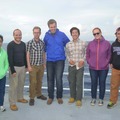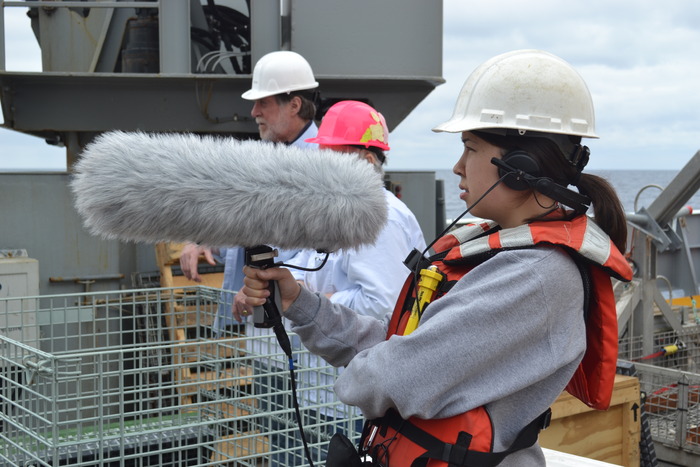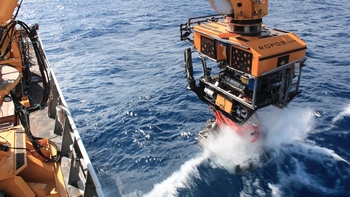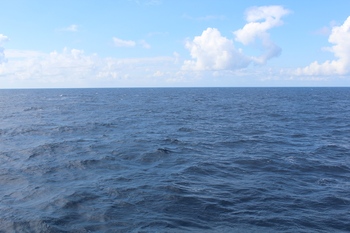27 July 2014
Coming Together
Our respective final projects are making good progress; tomorrow we will show our projects to Deb and Leslie for feedback as the cruise winds down, so it is exciting to see projects begin to take a presentable form. While we have chosen specific and reasonable goals to be completed on the ship in these 16 days, new concepts and topics for video have formed throughout the process that we would love to develop if given the time. On the instrument video project, Charles, Don, and I aim to produce a few specific videos before our arrival in Newport, explaining the purpose and operation of instruments including the HD video camera, the temperature-resistivity probe, and the mass spectrometer.
Right now, I am working on the instrument video on the temperature-resistivity probe. After planning the general flow of information, I collaborated with Charles and Don to write the script for the ~3-minute video, along with indicators for what images and video footage would accompany the narration. After much revision, I finally recorded and edited the audio track yesterday evening. Today, I’ll piece together the video with video footage of the hydrothermal vent site (Escargot), a demonstration and close-ups of the instrument, and our interview with Eric Olson, an instrument engineer on the ship. I haven’t had much experience with producing videos, but many of the other students have become familiar with video editing software like FinalCut Pro during the cruise, so their help will be valuable. Similarly, I was one of the first to use Ed’s audio recording equipment (for our interviews), and I already had good knowledge of audio editing through a program called Audacity. In this way we barter skills—helping one another in our own given strengths, which is especially useful since so many of us are producing video media as some component of our group project.
24 July 2014
We had a calm spell, where the water seemed plastic, continuous and smooth, not like the angles that form when the slightest wind pushes. The reflection of the sun on the water made the surface seem resilient and thick, as if a marble dropped on it would bounce before reluctantly dropping into the sea. In the last day or so, the water’s surface has returned to its rough texture with rippling miniature triangular peaks, even making large swells beneath the boat and occasionally splashing over the edge of the deck. Yesterday, when deploying ROPOS the waves lapped against the instrument basket as it hung over the side of the boat. This type of motion poses risk to the cable that suspends the ROV and package, and we waited until noon today to dive again. Tonight the weather seems to be calmer, so ROPOS will be busy shuttling instruments and J-boxes to the seafloor.
Since we heard Leslie’s talk on lava flow morphology, we’ve recognized many of the sheet, lobate, and pillow basalts that she showed. Now, we’re not only able to properly log the lava flows that ROPOS encounters, but we also have some understanding of the conditions under which the basalts formed. The live stream of the geology some 1-2 km beneath us is incredible to watch for so many reasons—the extraordinary quality of the actual footage, the seafloor itself, the larger project being completed, and that this is occurring right below us. We look out and just see the ocean waving around us, otherwise oblivious to the volcano it contains. On the last few dives, we’ve watched several instruments find their new homes among the basalt features. These are the same instruments that we know from the back deck and benches in the main lab, first being adjusted and calibrated and one-last-time tested, then being fitted with bungee cords and red handles for ROPOS to unpack and assemble at the seafloor. So much energy has been put into those pieces by the instrument engineers onboard, and it almost feels like saying goodbye, seeing them in a different underwater world. But we’ll be back for them later for maintenance, and we’ll talk to them in the time in between through the cables leading back to shore.
19 July 2014
Do You Hear What I Hear?
One of the first things I noticed about living on the Thompson was the ambient noise. The continuous gasp of the air conditioning follows from room to room, and on the deck the sputter of ocean waves mixes with the sound of engines and machinery. The rhythmic shudder of the engines below can be heard from most levels within the ship, their starting and stopping accompanied by a slow squeal. The students sleep one level below the main deck in the Forward Science Berthing near the bow of the ship, and we have become very familiar with the steady dulled hacking of the motors behind us and with the resonant slapping of water beside us. When the boat rocks, water can be heard sloshing below as well, crashing from side to side in the anti-rolling tank which stabilizes the ship in rough seas. With this collage of external sounds, a higher pitched vacuum-like noise comes from the vents above us circulating air about the boat. There is music, but not a particularly common sound onboard—the mindless plucking of a guitar in the library, classics and oldies from the kitchen, Swedish death metal in the dark ROPOS control room. The noise isn’t overbearing—I’m not getting headaches or anything like that—but I think I will be relieved to be in relative silence in two weeks’ time, much like the dullness the ears feel immediately following a concert.
It is odd to realize how isolated we are from humanity, yet there is no quiet place on the boat. Usually, it seems, when people seek to surround themselves by nature, they do so for the serenity and calm that accompany a remote campsite in the woods or mountains. By contrast, we seem to have accomplished the opposite—populating a small part of the desolate ocean surface with an intense human presence. This is likely a good thing, as I have no feeling of being stranded in the middle of the ocean until I stand on the deck of the ship and concentrate on that thought while looking out to the edge of our view.
---
In the way of student projects, Don, Charles, and I are collaborating on a handful of informational videos about the many special instruments being installed on the seafloor. We hope that these videos will provide background and context for the webpages that already exist on this VISIONS website. Beyond the parameters they measure, these instruments are especially interesting due to their adaptations for long-term operation on the ocean floor—a cold (~2°C), high-pressure (over 200 atmospheres) environment a mile beneath the surface and more than 200 miles from our home laboratories on shore. Some are designed for use directly in contact with hydrothermal vent fluids, which are highly acidic with temperatures exceeding 50°C at Axial Seamount. Many of the scientists and engineers onboard prepared these instruments for use in these conditions, and we will feature their expertise in our videos. In the last few days, we have interviewed several people about the broadband seismometer, temperature-resistivity probe, and HD camera. If all three of us are available for an interview segment, Don mans a video camera, I monitor the audio (with precautions to minimize noise from the background sounds described above), and Charles asks the tough questions. These segments will be joined with additional footage of the instruments alone and of their installation by ROPOS (once that occurs later on during this leg).
16 July 2014
Constant Motion
As incredibly dense as it sounds, I often forget that we are in the middle of the Pacific Ocean. The nature of the vessel, the people on it, and their activities make the place feel comfortable, not stranded and isolated. The ship is deliberate, in many senses; we are not at the mercy of the ocean, adrift, but instead use the engines to maintain our position above Axial Seamount’s base. Every instrument which is being deployed to the seafloor must be tested, and tested again, before being strategically secured to the ROPOS baskets. The people on board are deliberate, too, focused and productive; work takes place all day, each day of the week. The ship is transport, home, office, and lab, and the many projects onboard pause only for meals, breaks, and sleep.
The shifting floor below us is a reminder of our situation atop the Pacific. We aren’t in a normal science laboratory. Through the open door from the main lab out onto the deck, the horizon moves up and down as the boat rocks. With a strong swell against our feet and chairs, the sea slides into full view as the vessel points downward; then it pitches back and the horizon aft creeps back into view until the door opens to the sky. Yesterday night, the motion of the ship picked up, and the second ROPOS dive was delayed for weather. In the meantime, we performed a CTD cast off the side of the ship, recording oxygen concentrations, temperature, salinity, and density as the instrument moves from surface to a depth of 2580 m. Once the CTD returned to the deck, we gathered water samples from various depths to calibrate the salinity and oxygen measurements.
The Thompson is a living creature in itself, with rhythms and distinct parts, but never entirely at rest. Someone is in the engine room and the galley and the bridge, someone is planning the next dive, someone is on watch, someone is editing video. It’s noticeably subdued during my 0400-0800 watch shift, but never lights out. The ship has a human element, in that as a whole, it seeks to understand the world beneath it, to look and feel and see the ocean’s depths. The hydrothermal vents beneath us punctuate the bare ocean floor, teeming with life and activity unlike anything near it; in the same way, the Thompson is a hot spot of human creativity and determination. We’re a small dot on the ocean’s surface, and those inhabiting it are unique and incredible people.
14 July 2014
Pitch and Roll
We’ve been doing a lot of pitching and rolling:
Pitching in when there’s all manner of computers, monitors, routers to be tied down; there’s power cords and network cables to zip-tie along the ceiling (done at Pier 90 on July 12th).
Pitching ideas to chief scientists, engineers, ROPOS navigators for interviews and tours and video projects. We meet often in student groups, informally and planned. While I’m collaborating primarily with Charles and Don for our video projects, all the students share ideas and plans. Expertise is easy to find on board; everyone is happy to chat with us about their work, making an incredibly friendly, accessible environment despite the magnitude and complexity of the project as a whole.
Rolling the compiled video footage from Don’s many time-lapse photo shoots, including sunset and sunrise over Seattle, loading the R/V Thompson, and departing Pier 90.
Rolling up gumby suits, feet first, flat on the ground. We donned them after the science party’s safety briefing on Sunday (July 13th), and after a fire drill at 1415, a life-jacket-clad crowd gathered around the World Cup final on a wall-mounted monitor. Jersey colors were still distinguishable through the highly pixelated stream, so we watched on until Germany’s final victory.
Rolling out of bed before dawn on Monday (July 14th) for a pre-breakfast talk by Chief Scientist and big thinker John Delaney about the oceans and the Ocean Observatories Initiative (oceanobservatories.org). Many of us quickly rolled back into bed, driven by sleepy minds and/or queasy sea-stomachs.
Regrettably, no rolls so far from the galley at meals, but we have had some excellent blueberry scones and sliced bread loaves. Maybe the tuna wraps count? (edit: cheese rolls with dinner tonight, accompanying simple fare: rockfish, ribeye steak, sautéed mushrooms, baked potatoes, salad, fresh fruit and carrot cake.)
Perhaps most notably, we’re pitching and rolling right into the Pacific Ocean. As we passed through the Strait of Juan de Fuca into open ocean yesterday, the water became choppy and we began to feel the vessel sway, this way, now that; and irregularly too! Not the simple, even rocking of a hammock, but an uncertain and half-hearted shoving of heavy ocean water against the Thompson. The air is punctuated by deep, threatening thuds (and the occasional ringing bang) that make you think an unlatched door is swinging free against its metal frame, or a table has fallen, or something massive and metal is rolling about the main lab or in storage; but this is just water—just water—lapping the boat’s sides. Upon waking this morning for John’s lecture, the boat’s rocking was stronger than that which sent me to sleep; I was worried for the first few hours that I might fall sick. I had water and felt well enough to have breakfast at 0715, and since then (plus a nap), I haven’t been uncomfortable. Thankfully, my biggest challenge seems to be walking around the boat, but with a slow pace and a free hand it’s not unreasonable. When riding in a car, I have always loved the feeling of weightlessness when it crests a small hill, and my stomach floats into my chest; it’s a similar phenomenon when sitting or lying down on the boat, as the most I feel is the rise and fall (not side-to-side) moving of the vessel. I hesitate to say I enjoy the feeling, since a couple of our peers have had more difficulty adjusting. For now, I’m just glad to have the good fortune of fine health, and I’m looking forward to arriving at Axial tonight at around 2 a.m.





